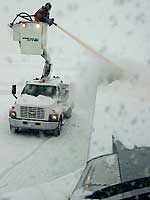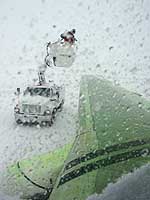Have you ever wondered how they de-ice a plane? De-icing is actually a two step procedure where one type of fluid is used to remove ice and snow, and another fluid is used to prevent frozen build-up during take off.
 There has been controversy in the past regarding when a plane should be de-iced. Some have argued that when it is lightly snowing and not sticking to the plane's wings, de-icing is not necessary. The tightening of regulations in the late 1990's pretty much guarantees that if there is any sort of frozen precipitation, sticking to the plane or not, de-icing and anti-icing will be initiated.
There has been controversy in the past regarding when a plane should be de-iced. Some have argued that when it is lightly snowing and not sticking to the plane's wings, de-icing is not necessary. The tightening of regulations in the late 1990's pretty much guarantees that if there is any sort of frozen precipitation, sticking to the plane or not, de-icing and anti-icing will be initiated.
The procedure starts with a high-pressure hose spraying an ethylene-glycol or propylene-glycol mixture that is specially formulated to remove all frozen deposits, even in temperatures of -45 degrees Celcius. Once the wing has been thoroughly treated with the orange liquid, it is on to the next step, anti-icing.
Now it is time to squirt green stuff all over the wing! The application of the anti-icing liquid is very interesting. First, the application is done with low pressure "spurting" technique so that the fluid hits the wing in gobs, sticking to it. The liquid is applied in this way to ensure a complete coating of the wing. The anti-icing fluid contains thickening agents to make it kind of gooey. The whole idea is to maintain the anti-icing protection as long as possible into take-off. Once the plane reaches high speed, all the anti-icing fluid slides off the wing. It's that simple!
If you are interested in the exact composition of these de-icing agents, this Dow link will tell you what you want to know. It should be noted that while these are very useful life-saving chemicals, there have been environmental concerns to the spraying of ethylene glycol. Airports are supposed to take measures to limit exposure to de-icing liquids.



